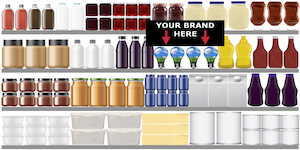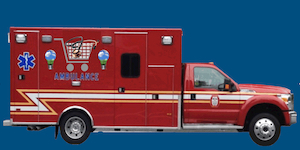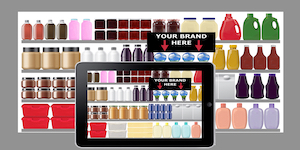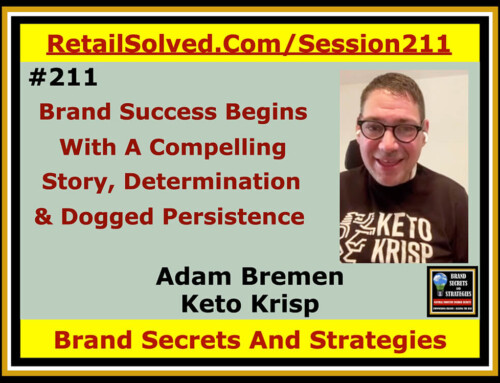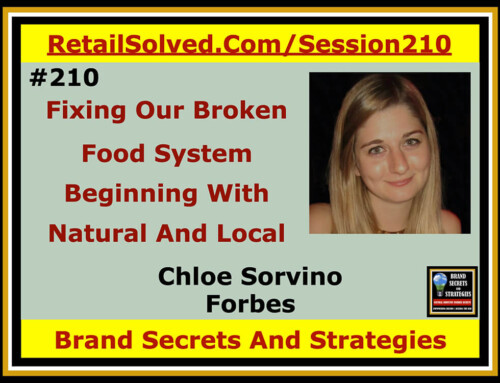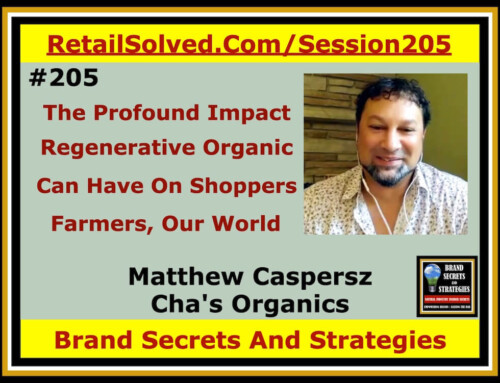New product innovation is the lifeblood of every brand. New products fuel sustainable growth, attracts new shoppers and increases brand awareness. Know the critical steps to get your product on more retailer’s shelves and into the hands of more shoppers.
The 11 Most Important Things Retailers REALLY Want
#1 A Consistent Clear And Compelling Brand Message 
“You never get a second chance to disappoint a customer”
The strength of every brand is the connection you make with shoppers. You want customers to like, know, and trust your brand. First impressions matter – make every impression memorable.
Have you ever played the game where you share a story with someone and they share it with someone else and so on? Your story is unrecognizable by the time it comes back around to you. All brands struggle with this dilemma.
Every impression your brand makes on a retailer’s shelf, online, on social media, in the press, by brand ambassadors, and with every customer needs to include the same consistent authenticity, passion, and enthusiasm as originally shared by the founder.
Your selling story also needs to be compelling and inspiring. Genuine shopper loyalty is earned and not embossed on a plastic card. The true value of your brand to any retailer is the customer you attract.
This is the single most powerful point of leverage you have when negotiating with retailers. The customer your brand drives into their store is worth far more than the slotting and other fees they charge.
Most of the bad press, problems, or missed opportunities that cause brands to falter or fail are due to a lack of clear and consistent communication. This begins with your selling story. Your selling story needs to be an extension of your brand!
Your selling story unites shoppers around a common cause or community. Brands that build a strong and vibrant connected community have the ability to drive sustainable sales in both traditional and online retail. This is how you build real loyalty.
The side benefit is that your community can help guide you to create products they will want and will support. Every brand needs to own their customers – beyond a retailer’s shelf. This is the best way to do that.
Your brand story is the foundation you build your brand on – make sure it’s solid! Your sales story needs to be turnkey, and it needs to be baked into every aspect of your sales funnel and brand message.
Your TURNKEY SALES STORY STRATEGY will help you attract loyal shoppers, get your brand on more retailer’s shelves, expand distribution, improve merchandising, and help you understand what retailers REALLY want. It’s your roadmap to success.
#2 A Blueprint To Ensure Category Growth 
We have all heard the expression that a picture is worth a thousand words. Especially pictures and stories that resonate with us and leave a lasting impression.
A picture is more impactful than charts, facts, and figures. It is the primary element in building trust with your shoppers.
“Shoppers can't buy your products if they can't find them.”
The first impression that most consumers have of your brand is on a retailer’s shelf. Most shoppers search for their favorite brand first. Make sure your product stands out on the crowded shelf. On-shelf merchandising IS your first impression!
You put a lot of energy into branding your packaging. Make it easy so current and future shoppers buy your products over the competition. Shelf merchandising needs to be consistent across every store and every retailer, especially at health food stores.
Poor product placement and confusing merchandising are the single biggest problem most brands face. You worked hard to get your products on the shelf – make it counts! Identify the prime location for your brand and validate it with fact-based insights.
Retailers use planograms to map where your products will be merchandised. Grocery stores are broken into categories of similar and complementary products. An effective brand-building strategy is to provide planogram/schematic recommendations.
There are a lot of creative and low-cost solutions available. Providing a visual merchandising recommendation will make it easy for retailers to say yes to your new items. This will help you LAND SHELF SPACE AND WIN AT RETAIL.
#3 Know The Health Of Your Brand 
Small brands don’t have the velocity to compete against big brands. Traditional category management tends to overlook small brands as a result. Your brand health includes your contribution to sustainable category growth.
Small health-focused brands provide sustainable growth across almost every category. In their absence, most categories would be down or declining. I proved this in a feature article for the 2016 Category Management Handbook.
Brand Health ≠ Cash In The Bank
The real health of your brand is measured by the profitable growth it drives in the category. The real health of your brand is its ability to drives sales at a premium price. Premium products that are organic, gluten free, allergy free, that support a plant-based diet, etc drive contribution in the category – what retailers REALLY want.
The health of your brand is measured by it’s contribution to the category in the form of sales and profits. This is critically important to every retailer. They want to know that if they place your product on their shelves it will increase profits and shopper foot traffic.
While other brands brag about their product's category ranking, you need to focus on how your brand contributes more to sustainable category growth than they do.
Most of the business schools and programs available to small brands are focused on how to get more funding to support your growth. Wouldn’t it make more sense to focus on getting the most out of the resources you already have? I want to challenge the notion that a brand’s CEO needs to be a perpetual fundraiser.
Better yet, brands that are able to capitalize on all of these points will have the sales to appeal to potential investors who offer more attractive terms.
The health of your brand is measured by your sales WHERE you have distribution. In other words, how are your products performing in the stores that sell them? Make ASSESSING THE HEALTH OF YOUR BRAND a priority before every retailer appointment and new product introduction.
#4 Maximize Your Promotion Effectiveness 
This is a big one! Every dollar spent to get your products into the hands of shoppers is called trade marketing. The challenge is that most promotional spending is ineffective and wasted. Effective promotions expand runway, grow sustainable sales & maximize your promotional ROI.
Trade marketing encompasses everything required to get your products into shopper’s hands. Promotions are required by retailers, distributors, and shoppers expect them. They can add rocket fuel to your sales when done correctly or they can bankrupt you when they fail.
Trade promotions typically represent the largest expense for every brand’s income statement. This literally affects every aspect of your brand’s success and it can determine how many months, days or years your brand will be around.
The harsh reality is that most promotions fail to achieve their objective. I’ve heard estimates of over 70% of promotional spending is wasted.
“You can not afford to get this wrong!”
Let's face it, retail is “pay to play” and big brands have a substantial unfair competitive advantage. You feel like the deck is stacked against you and for good reason – but it doesn't need to be.
What if I told you that there was a better way? What if I told you that you were not alone and that even the big brands struggle with this? It's true – and I have first-hand knowledge working with retailers as well as big and small brands.
Additionally, I've had the unique opportunity to design, build, execute, and measure promotions where I've had unlimited access to the resources needed to measure promotional effectiveness down to the contribution back to the brand and retailer. Many of the tools and strategies I created are still in use today by large and small brands.
Brands need to own this and not farm it out! Brands need to commit to learning PROVEN STRATEGIES TO MAXIMIZE TRADE MARKETING ROI.
#5 Know Your Numbers 
The number one question I get asked by brands listening to my podcast is what are the best reports I need to drive sales and grow my brand? Sadly, most brands use reports that do not reflect how consumers buy their products – even the big brands. This is an expensive and huge waste of money.
You’ve most likely been told that bringing canned topline reports to your retail appointments is critical to your success. The reality is that most canned topline reports are simply a waste of ink and paper.
Sounds like a pretty harsh statement, let me explain. Savvy retailers already know how your brand is performing on their shelves. They do not need a report confirming what they already know. They do not need a report telling them the exact same thing every other brand is telling them – even with your unique spin.
What they REALLY need are actionable insights that they do not have access to on their own. They need actionable insights that your competitors are not providing them. Retailers also need you to help them compete more effectively in their market.
Every retailer needs to know that if they put your product on their shelves that it will grow category sales and increase shopper traffic in their stores. Once that happens, you then need to validate and reinforce that your brand deserves to remain on their shelves because it continues to achieve those results.
“Retailers want insights. Actionable insights.”
The most effective way to do this is with sales data – fact-based selling. It’s critical that you use the right kind of data to tell your selling story and differentiate your brand from your competitors.
Traditional methodologies focus exclusively on metrics that overlook the contribution natural brands provide. I have a much better solution that has a long successful track record!
Brands need to go beyond canned topline reports. Brands need to learn how to MINE THE DATA MAZE. They need to include actionable insights to tell a compelling sales story – what retailers really want!
#6 Offer The Right Mix Of Product Shoppers Want To Buy 
Step back and think about the way you make purchases. Everything is about perception. Does the store have a good assortment of the products you want to buy? Are their prices fair?
You never get a second chance to disappoint a customer. Getting your products into the hands of more shoppers is critical to increasing sustainable sales. It’s critical to your very survival.
You have a choice and its a simple one. Either manage your own distribution and merchandising or trust it to anyone BUT you. Do you trust your competitors to protect your merchandising and distribution when they present their new items? Of course not!
“Remember that everything is negotiable – especially in this industry.”
Retailers cannot possibly be experts in every category, on every item they sell, and on your loyal shopper. They need your help! They need you to support and help guide them to merchandise the right products that keep shoppers returning.
Every time any new product is presented to a retailer, one product needs to be discontinued to make room for it. Many times, the decision is made solely on a brand’s performance – or lack of performance. This can be a huge mistake.
Most strategies focus narrowly on individual item sales and overlook how your product interacts with other items in the store. In most cases, your sales have an impact on the sales of other items making your product more valuable to the retailer when they consider the shopper's total purchase at checkout.
These are important things that need to be considered when making those decisions, the things that are really important that others frequently overlook. These are the skills that most sophisticated brands use that gives them a substantial competitive advantage. This is how you level the playing field and compete head-to head-with the big brands.
Brands need to help retailers MAXIMIZE SALES WITH THE RIGHT PRODUCT ASSORTMENT.
#7 Adopt The Advanced Strategies Big Brands Depend On 
Retailers want and need brands willing and able to help them drive profitable category sales, increase shopper foot traffic, and convert occasional customers into loyal evangelists. Big brands rely on the advanced strategies championed by category management experts.
Category Management is the great equalizer between big and small brands. It is also one of the most overused and misunderstood terms in the natural channel.
Category Management includes the advanced strategies required to make it easier for customers to find your products where they shop with effective merchandising, increased distribution, maximizing your promotional effectiveness, reducing wasteful trade spending, differentiating your brand at retail, giving you more runway from your funding, growing sustainable sales in any economy, reduce and even eliminate out-of-stocks which equals disappointed customers and lost sales, help you stand out on a crowded shelf, help you develop a loyal committed community around your brand, and much much more.
It can level the playing field, giving you a substantial significant competitive advantage. More importantly, it can help you save valuable time and money. This is why big brands rely so heavily on category management. It’s proven itself repeatedly to be the best sales driver for brands and retailers.
This is the most important skill every brand, retailer, and entrepreneur needs in their tool-box.
“If you want to play at the level of the big brands,
you need to BE at their level.”
Traditional category management relies heavily on canned topline reports and templates. While these are a great starting place for any analysis, they are NOT enough to help differentiate you from your competition. Most of these strategies lack creativity and rely heavily on what I call “push button category management.”
I coined the term “True Category Management” many years ago to help brands like yours take this to the next level and beyond. I’ve spent my career pushing big brands around effectively beating them at their game because I focus on what really matters – the customer. Nothing happens until someone buys something and shoppers can’t buy your products if they can’t find them.
True category management focuses on the basics – what retailers REALLY need from you and your brand. It then overlays those strategies to help you help your retailer partner compete at the highest levels. It looks at the customer journey from the shopper’s perspective.
I believe that retailers and brands spend most of their energy trying to get us to buy the stuff on their shelves as opposed to selling us what we want to buy. This is where you come in. Like the ripple in the pond, true category management focuses on what shoppers want both in traditional brick-and-mortar and online retail.
I believe that every brand needs to captain their own ship. Brands need to commit to the advanced strategies found in TRUE CATEGORY MANAGEMENT – THE ROADMAP TO SALES SUCCESS. It can add rocket fuel to your growth.
#8 Maximize Each And Every Selling Opportunity 
Your entire sales team needs to be in lock-step and they need to communicate your selling story with a unified and consistent voice. This includes both your internal and external sales team.
Several years ago I wrote an article about maximizing broker effectiveness. It led to me being a regular New Hope and Whole Food’s Magazine contributor, and a speaker at the Natural Products Expo in addition to many other industry events. It has since led to me getting over 300+ articles published in most of the leading industry publications, my popular podcast, and weekly newsletter – most focusing on this topic and much more.
This is a topic I get asked about a lot when I mentor and work with brands including on my Brand Secrets And Strategies Podcast. For example, SECRETS 089 The importance of having a solid digital brand selling strategy with Madeline Haydon of Nutpods.
You’re told you need a broker. But do you really know how to use them to get the best results for your brand? In that article, I focused on leveraging your broker as an extension of your sales team and then holding them accountable for achieving results, same as you would any employee.
When I started in this industry decades ago, large brands had a direct sales force that did everything to drive sales including all merchandising, sales calls, category management, demos, etc. This is very expensive so many of those brands adopted a blended model where the brands made the sales call and the broker handled the merchandising.
In many cases today, brokers do just about everything for the brands they represent. I continually hear from brands about their love-hate relationship with their brokers. Most of this is due to a lack of clear communication and expectations on the brand’s part.
The brands that have the most difficulty with brokers have effectively handed their keys to their brand over to them, expecting the broker to work miracles on their behalf. They are then disappointed when their expectations are not met when in fact those expectations are unrealistic and not well defined.
Like any profession, there are good and bad brokers just like there are good and bad consultants, doctors, mechanics, and so on. For this reason, I believe that every brand needs to remain firmly in charge of their brand’s strategy, to remain the captain of their ship.
Think about it. You’ve worked hard to build a product that consumers love. Your passion, your enthusiasm, and your dedication has propelled your success thus far. The best path forward is to have everyone on your sales team share your passion, your enthusiasm, and your commitment in the same voice as the founder.
I am a firm believer that every brand needs to remain fully engaged in their success – in every aspect of their sales strategy.
Think about it, you poured everything you have into creating an amazing product, right? So why wouldn’t you put the same love and attention into getting your product onto more retailer’s shelves and into the hands of more shoppers? Why wouldn’t you apply the same level of creativity and passion to your selling strategy? Brands need SIMPLE SOLUTIONS TO MAXIMIZE BROKER EFFECTIVENESS and take their sales to the next level and beyond.
#9 Convert Occasional Customers Into Loyal Shoppers 
Real shopper loyalty is earned and not embossed on plastic cards. Real loyalty converts casual customers into brand ambassadors.
The sole focus of every merchandising strategy should be on making it easy for shoppers to find your products. Sounds simple right? But it’s not that easy. This is the same goal for every brand and item in every retail store. You are competing for the attention of every shopper along with every other brand.
Most merchandising strategies focus narrowly on individual items sales and overlook how your product interacts with other items in the store. In most cases, your sales have an impact on the sales of other items, making your product more valuable to the retailer when they consider the shopper’s total purchase at checkout.
Effective merchandising helps to maximize each and every selling opportunity. It helps to make it easier for shoppers to purchase your products and find them across every store and category. These strategies can act as a line of breadcrumbs making it easier for the customer to buy your products.
Consider the shopper journey. How does a new customer find your product? How can you ensure that they choose your product over your competition? Brands need to adopt a MERCHANDISING CHECKLIST TO GROW SALES & LOYALTY.
#10 Make It Easy For Shoppers To Find Your Products 
Consumers want and appreciate retailers who make shopping easy, convenient, and stress-free, saving them valuable time and money.
Shoppers literally have unlimited choices when it comes to where they spend their hard-earned money. Every retailer, both traditional and online, are fighting for every shopper’s attention.
Online retailers have a significant competitive advantage in that they can be more flexible with pricing and promotion compared to their traditional retail competitors. Additionally, online retailers have a much greater opportunity to educate shoppers about the products they sell.
Traditional brick and mortar retailers need to work hard to level the playing field if they want to succeed. The best way to do this is to partner with the brands they sell. The most effective strategy for every retailer is to develop strategies that encourage your unique consumer to shop their store.
Merchandising is the first impression a customer has of a store. It communicates the store’s commitment to their shoppers. Retailers need your help to ensure that shoppers have a reason to return and bring their friends, MERCHANDISING STRATEGIES TO INCREASE SALES & SHOPPERS.
#11 Focus On Shopper’s Market Basket Size To Increase Sales 
Market basket size is the most effective way to measure a brand’s true value. It’s key to driving true loyalty & gaining a competitive advantage.
The market basket is the sum total in dollars of the shopper’s total purchases on a shopping trip. This is perhaps the most valuable metric for any brand. You’re taught to pay attention to your sales volume and products ranking within the category but this overlooks what REALLY matters most to the retailer.
The value of your brand to a retailer extends well beyond your products. When shoppers purchase your products, they purchase complementary products throughout the store like gluten-free, etc. Therefore your customers are most likely more valuable to the retailer than your mainstream counterpart.
Understanding how to leverage this is critically important to your future. You should never try to compete on your sales velocity alone. You are worth far more to the retailer than the ingredients in your product.
The true value of your brand is the customer who buys it – the customer that goes out of their way to choose your brand over the competition.
Retailers generically don’t make anything. What they sell is the real-estate your brand occupies on their shelves. They want a competitive edge in their market and these strategies are how you help them accomplish that – STRATEGIES TO INCREASE MARKET BASKET SIZE & SALES.
Leverage these important strategies for every new item introduction and on every retailer appointment. They will help you accelerate your brand sales and stand out on a crowded shelf.
Reach out to me with any questions. I always enjoy hearing from you and I look forward to supporting you in your success!
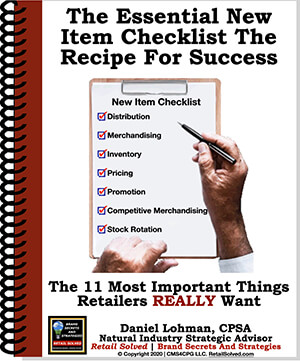
Want A Competitive Edge? The Recipe For Success
New product innovation is the lifeblood of every brand. New products fuel sustainable growth, attract new shoppers and increase brand awareness. Know the critical steps to get your product on more retailer’s shelves and into the hands of more shoppers.
Empowering Brands | Raising The Bar
Ever wish you just had a roadmap? Well, now you do!
Don’t miss out on all of these FREE RESOURCES (strategic downloadable guides, podcast episodes, list of questions you need to be asking, and know the answers to, the weekly newsletter, articles, and tips of the week. You will also receive access to quick and easy online courses that teach you how to get your brand on the shelf, expand distribution, understand what retailers REALLY want, and address your most pressing challenges and questions.
All tools that you can use, AT NO CHARGE TO YOU, to save you valuable time and money and grow your sales today!
Image is the property of CMS4CPG LLC, distribution or reproduction is expressively prohibited.



